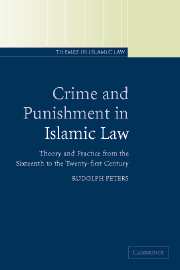 Crime and Punishment in Islamic Law
Crime and Punishment in Islamic Law Book contents
- Frontmatter
- Contents
- Acknowledgements
- Maps
- 1 Introduction
- 2 The classical doctrine
- 3 The implementation of Islamic criminal law in the pre-modern period: the Ottoman Empire
- 4 The eclipse of Islamic criminal law
- 5 Islamic criminal law today
- 6 Conclusion
- Glossary of technical terms
- Bibliography
- Suggestions for further reading
- Index
3 - The implementation of Islamic criminal law in the pre-modern period: the Ottoman Empire
Published online by Cambridge University Press: 23 November 2009
- Frontmatter
- Contents
- Acknowledgements
- Maps
- 1 Introduction
- 2 The classical doctrine
- 3 The implementation of Islamic criminal law in the pre-modern period: the Ottoman Empire
- 4 The eclipse of Islamic criminal law
- 5 Islamic criminal law today
- 6 Conclusion
- Glossary of technical terms
- Bibliography
- Suggestions for further reading
- Index
Summary
INTRODUCTION
In this chapter I will examine how, during the pre-modern period, the state punished criminals and what role the doctrine of the Shari῾a played in it. Since there was a great deal of variation, both regional and temporal, I will focus, for the reasons I mentioned in the introduction, on the Ottoman Empire. Here a legal system developed on the basis of the Hanafite doctrine and supplemented by state legislation (qānūn). In § 3.2 I will discuss this specifically Ottoman legal system. According to the classical doctrine the enforcement of criminal law was the duty of both the qāḍī and the executive authorities. In order to understand a given system of criminal law in the world of Islam, it is important to examine the distribution of judicial powers between the qāḍīs and the state officials authorised to punish criminals. How these jurisdictions were defined in the Ottoman Empire is the subject of § 3.3. In the following section matters related to procedure, such as arrest, investigation of crimes and sentencing will be discussed. The last section of this chapter (§ 3.5) deals with substantive law as applied by the courts. Here I will examine the extent to which the Shari῾a was applied, the role of legislation and finally the range of punishments that were enforced.
Many European observers found that the Ottoman legal system with its swift justice compared favourably with European legal practice, characterised by long-drawn-out and costly procedures.
- Type
- Chapter
- Information
- Crime and Punishment in Islamic LawTheory and Practice from the Sixteenth to the Twenty-First Century, pp. 69 - 102Publisher: Cambridge University PressPrint publication year: 2006
